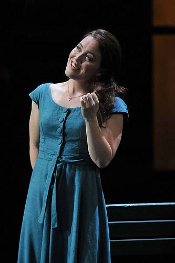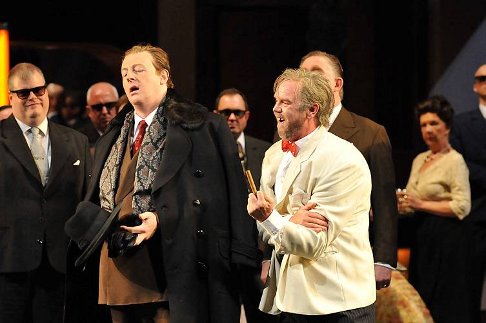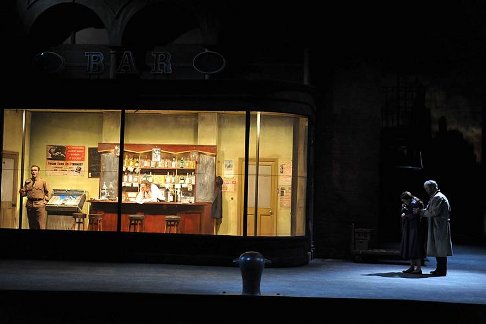11 Oct 2009
Rigoletto at ENO
There is something quote refreshing about the fact that a staging as characterful as Jonathan Miller's 27-year-old “New York Mafia” Rigoletto is the nearest thing to a warhorse that ENO has in its repertoire.

There is something quote refreshing about the fact that a staging as characterful as Jonathan Miller's 27-year-old “New York Mafia” Rigoletto is the nearest thing to a warhorse that ENO has in its repertoire.
It’s doubly refreshing this season to have Miller himself back to direct the revival, as he did last season with his Barber of Seville. It is in the detail that his influence is visible; the character inter-relationships are complex and clearly drawn, and for the first time I can recall, James Fenton’s classic translation is delivered in authentically-accented New York-ese instead of generic English RP. It all makes a difference.
The sets are looking a little dated (recreating the shapes and colours of the 1950s through 1982-tinted spectacles) and the lighting could do with a revamp. Both the backstreet outside Rigoletto's tenement block and the seedy riverside bar where Sparafucile makes his nefarious living are reliant upon lighting for their atmosphere, and at the moment it's all looking a bit dull and disinterested. But it remains a strong, tightly conceived show, with seemingly plenty of life left in it.
 Katherine Whyte (Gilda)
Katherine Whyte (Gilda)
In the title role was the evening's real star turn: Anthony Michaels-Moore,
too long absent from London’s stages and far, far too long absent from
the Coliseum. Compared with some of his predecessors in this production whose
physical presence have enabled them to dominate the stage overtly,
Michaels-Moore is much more subtle; his Rigoletto is a grubby little man with
an undercurrent of spite, embodying everything that is wrong with the world in
which he lives. And his singing is just spectacular — a masterclass in
Verdian line and phrasing.
In a trend becoming increasingly prevalent in ENO’s casting, the conductor and two of the key principals were imported from the other side of the Atlantic. (Don’t British singers have few enough home-grown opportunities as it is?) As Gilda, the young Canadian Katherine Whyte is a charming performer with a lovely limpid soprano and the ideal physique du role, but her voice is a good couple of sizes too small for this house and these colleagues, and instead of soaring over the top of ‘Si, vendetta’ (‘Yes, revenge’) and ‘Bella figlia dell’amore’ (‘If you want a faithful lover’) she was lost in the orchestral texture. I would very much like to hear her in this role again (well, really for the first time!) with one of the UK’s medium-sized companies, or perhaps here at the Coliseum again in a more sparsely scored opera — I see that most of her forthcoming work is in baroque and early classical repertoire.
 Ian Paterson (Monterone) and Anthony Michaels-Moore (Rigoletto)
Ian Paterson (Monterone) and Anthony Michaels-Moore (Rigoletto)
As the Duke, 25-year-old Michael Fabiano (from the USA) was a great deal more successful; a bright, brash, virile tenor with confidence and macho swagger in abundance. Only his very top notes had a tendency to be too bright, almost detached from the rest of his voice.
Company regulars took the other roles, with Brindley Sherratt’s darkly malevolent Sparafucile particularly outstanding. ENO Young Artist Madeleine Shaw was a credible Maddalena. Bass-baritone Iain Paterson (perhaps the brightest star to have emerged from the Young Artists’ Programme) is a little on the high side for Monterone and he didn’t quite manage the strength and firmness of tone which we are used to hearing from him.
 Anthony Michaels-Moore (Rigoletto) and Katherine Whyte (Gilda)
Anthony Michaels-Moore (Rigoletto) and Katherine Whyte (Gilda)
Stephen Lord, another American, conducted tautly and with brisk tempi for the most part; the only misjudgement was allowing Fabiano plenty of rubato in ‘La donna e mobile’ (‘Women abandon us’) — not an issue in itself, but inconsistent with Miller’s famous take on it whereby the Duke calls the song up on Sparafucile’s jukebox.
Ruth Elleson © 2009